 |
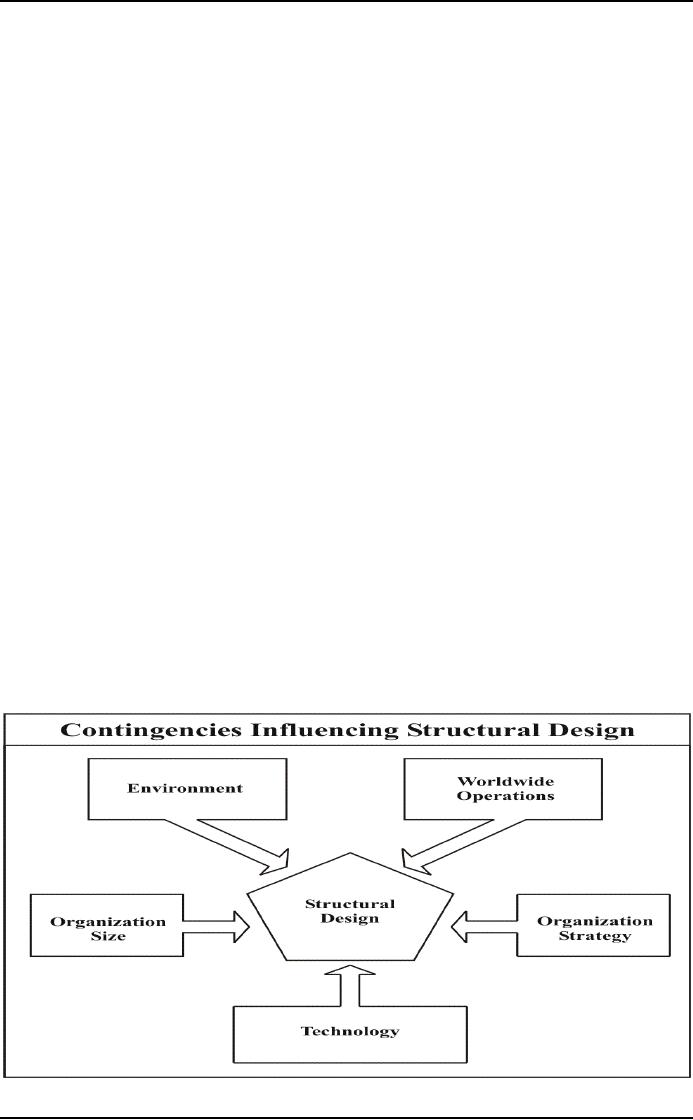
Organization
Development MGMT
628
VU
Lesson
34
Restructuring
Organizations
We begin to
examine techno-structural interventions
change programs focusing on the
technology and
structure
of organizations. Increasing global
competition and rapid technological
and environmental
changes
are forcing organizations to
restructure themselves from
rigid bureaucracies to leaner
more flexible
structures.
These new forms of organizing are
highly adaptive and cost
efficient. They often result in
fewer
managers
and employees and iii
streamlined work flows that
break down functional
barriers.
Interventions
aimed at structural design include moving
from more traditional ways
of dividing the
organization's
overall work, such as
functional, self-contained-unit and
matrix structures, to
more
integrative
and flexible forms, such as
process-based and network-based
structures. Diagnostic guidelines
help
determine which structure is appropriate
for particular organizational environments,
technologies, and
conditions.
Downsizing
seeks to reduce costs and
bureaucracy by decreasing the size of the
organization. This
reduction
in personnel can be accomplished
through layoffs, organization redesign,
and outsourcing, which
involves
moving functions that are
not part of the organization's core
competence to outside
contractors.
Successful
downsizing is closely aligned with the
organization's strategy.
Reengineering
radically redesigns the organization's
core work processes to give
tighter linkage and
coordination
among the different tasks. This
work-flow integration results in
faster, more responsive
task
performance.
Reengineering often is accomplished
with new information technology
that permits
employees
to control and coordinate work
processes more
effectively.
Structural
Design:
Organization
structure describes how the
overall work of the organization is
divided into subunits and
how
these
subunits are coordinated for
task completion It is a key
feature of an organization's
strategic
orientation.
Based on a contingency perspective shown
in Figure 41, organization structures should
be
designed
to fit with at least five
factors: the environment, organization
size, technology, organization
strategy
and worldwide operations. Organization
effectiveness depends on the extent to
which its structures
are
responsive to these
contingencies.
Organizations
traditionally have structured
themselves into one of three
forms: functional departments
that
are
task specialized; self-contained units
that are oriented to
specific products, customers, or
regions; or
matrix
structures that combine both
functional specialization and
self-containment. Faced with
accelerating
changes
in competitive environments and
technologies, however, organizations
increasingly have
redesigned
their structures into more
integrative and flexible forms. These
more recent innovations
include
process-based
structures that design
subunits around the organization's core
work processes, and
network-
based
structures that link the organization to
other, interdependent organizations. The
advantages,
disadvantages,
and contingencies of the different
structures are described
below.
Figure
41. Contingencies Influencing
Structural Design
The
Functional Organization:
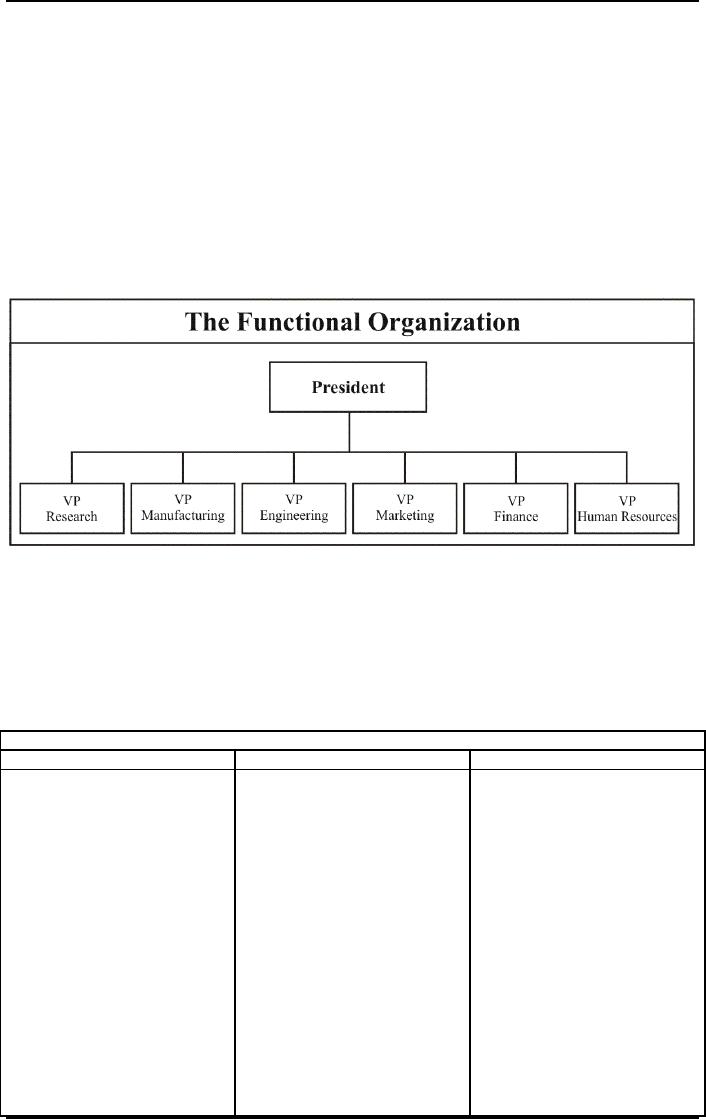
Organization
Development MGMT
628
VU
Perhaps
the most widely used organizational
structure in the world today is the basic
functional structure,
depicted
in figure 42. The organization
usually is subdivided into functional
units, such as engineering,
research,
operation, human resources,
finance, and marketing. This
structure is based on early
management
theories
regarding specialization line
and staff relations, span of control,
authority, and responsibility.
The
major
functional subunits are
staffed by specialists in such
disciplines as engineering and
accounting. It is
considered
easier to manage specialists if they
are grouped together under the same head
and if the head of
the
department has training and
experience in that particular
discipline.
Table
12 lists the advantages and
disadvantages of functional structures.
On the positive side, functional
structures
promote specialization of skills
and resources by grouping people
who perform similar work
and
face
similar problems. This grouping
facilitates communication within
departments and allows
specialists to
share
their expertise. It also
enhances career development within the
specialist, whether it is
accounting,
finance,
engineering, or sales. The
functional structure reduces
duplication of services because it
makes the
best
use of people and
resources.
Figure
42. The Functional
Organization
On
the negative side, functional
structures tend to promote
routine tasks with a limited
orientation.
Department
members focus on their own
tasks, rather than on the organization's
total task. This can
lead
to
conflict across functional
departments when each group
tries to maximize its own
performance without
considering
the performance of other units.
Coordination and scheduling
among departments can
be
difficult
when each emphasizes its
own perspective. As shown in
Table 12, the functional
structure tends to
work
best in small-to medium-sized firms in environments
that are relatively stable
and certain. These
organizations
typically have a small number of products
or services, and coordination
across specialized
units
is relatively easy. This structure
also is best suited to
routine technologies in which
there is
interdependence
within functions, arid to organizational goals
emphasizing efficiency and technical
quality.
Table
12: Advantages, Disadvantages, and
Contingencies of the Functional
Form
Advantages
Disadvantages
Contingencies
�
Emphasizes
�
Stable
�
routine
and
certain
Promotes
skill
�
tasks,
which encourages
environment
specialization
�
Small
to medium size
short
time horizons
�
Reduces
duplication of
�
Fosters
�
Routine
parochial
technology,
scarce
resources and uses
perspectives
by
interdependence
within
resources
full time
managers,
which limit
�
functions
Enhances
career
their
capabilities for top-
�
Goals
of efficiency and
development
for
management
positions
technical
quality
specialists
within large
�
Reduces
communication
departments
and
cooperation between
�
Facilitates
departments
communication
and
�
Multiplies
the
performance
because
interdepartmental
superiors
share expertise
dependencies,
which can
with
their subordinates
make
coordination and
�
Exposes
specialists to
scheduling
difficult
others
within the same
�
Obscures
accountability
specialty
for
overall outcomes
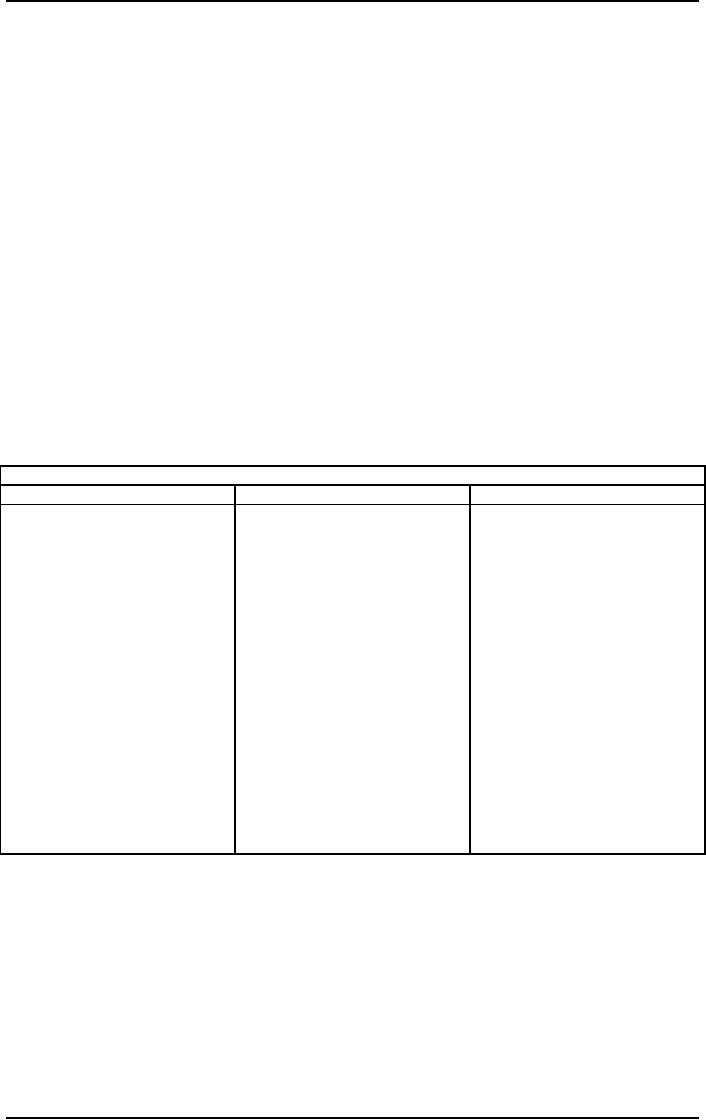
Organization
Development MGMT
628
VU
The
Self-Contained-Unit Organization:
The
self-contained-unit structure represents fundamentally
different way of organizing. Also
known as a
product
or divisional structure, it
was developed at about the same time by
General Motors, Sears,
Standard
Oil of New Jersey (Exxon),
and DuPont. It groups organizational
activities on the basis of
products,
services, customers, or geography.
All or most of the resources
necessary to accomplish a
specific
objective
are set up as a self-contained
unit headed by a product or
division manager. For
example, General
Electric
has plants that specialize
in making jet engines and
others that produce household
appliances. Each
plant
manager reports to a particular division or
product vice president, rather
than to a manufacturing vice
president.
In effect, a large organization may set
up smaller (sometimes temporary) special
purpose
organizations,
each geared to a specific
product, service, customer, or region. A
typical product structure is
shown
in Figure 43. It is interesting to note that, the
formal structure within a
self-contained unit often
is
functional
in nature.
Table
13 lists the advantages and
disadvantages of self-contained-unit structures.
These organizations
recognize
key interdependencies and coordinate
resources toward an overall
outcome. This strong outcome
orientation
ensures departmental accountability and
promotes cohesion among
those contributing to the
product.
These structures provide
employees with opportunities
for learning new skills and
expanding
knowledge
because workers can move
more easily among the
different specialties contributing to
the
product.
As a result, self-contained-unit structures
are well suited for
developing general managers.
Self-
contained-unit
organizations do have certain
problems. They may not have
enough specialized work to
use
people's
skills and abilities fully.
Specialists may feel isolated
from their professional
colleagues and may
fai1
to
advance in their career
specialty. The structures
may promote allegiance to department
rather than
organization
objectives. They also place
multiple demands on people, thereby
creating stress.
Table
13
Advantages,
Disadvantages and contingencies of the
Self-Contained-unit Form
Advantages
Disadvantages
Contingencies
�
Unstable
and uncertain
�
May
use skills
and
�
Recognizes
sources of
�
environments
resources
inefficiently
interdepartmental
�
Large
size
�
Limits
dependencies
career
�
Technological
�
advancement
by
fosters
an orientation
specialists
to movements
interdependence
across
toward
overall outcomes
out
of their departments
functions
and
clients
�
Impedes
specialists
�
Goals
�
of
product
allows
diversification and
esposure
to others within
specialization
and
expansion
of skills and
the
same specialties
innovation
training
�
Puts
multiple-role
�
ensures
accountability by
demands
on people and
departmental
managers
so
creates stress
and
so
promotes
�
May
promote
delegation
of authority
departmental
objectives,
and
responsibility
�
as
opposed to overall
heightens
departmental
organizational
objectives
cohesion
and
involvement
in work
The
self-contained-unit structure works best in
conditions almost the opposite of those
favoring a
functional
organization, as shown in Table 13.
The organization needs to be relatively
large to support the
duplication
of' resources assigned to the units.
Because each unit is
designed to fit a particular niche,
the
structure
adapts well to uncertain conditions.
Self-contained units also help to
coordinate technical
interdependencies
falling across functions and
are suited to goals
promoting product or
service
specialization
and innovation.
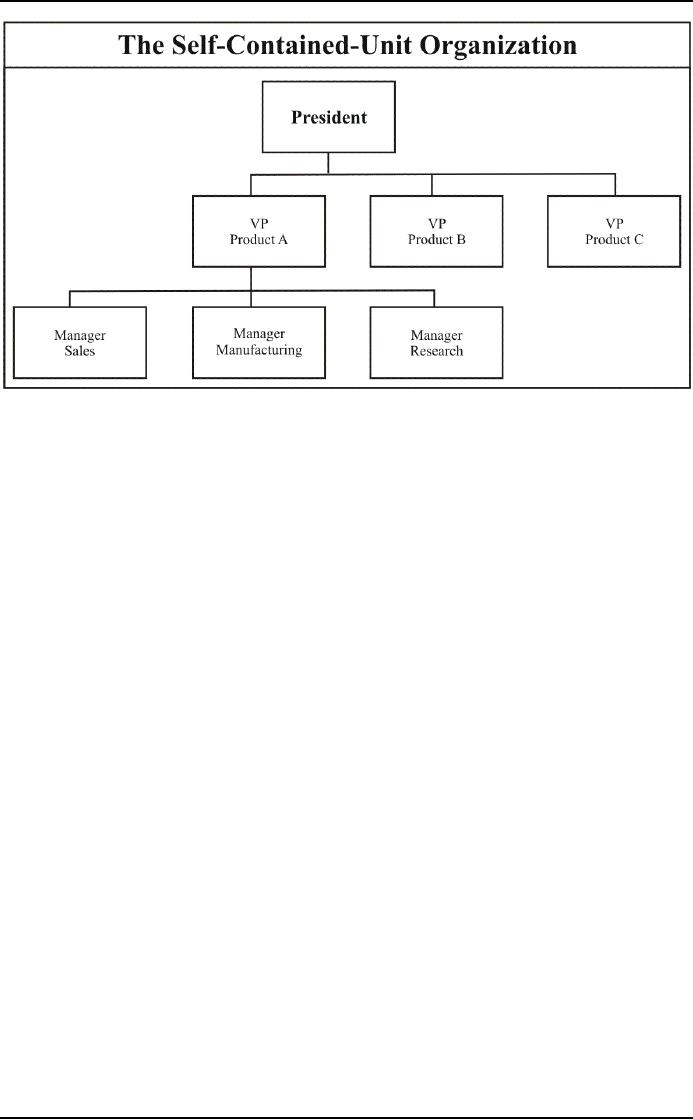
Organization
Development MGMT
628
VU
Figure
43: The Self-Contained-Unit
Organization
The
Matrix Organization:
Some
OD practitioners have focused on maximizing the
strengths and minimizing the
weaknesses of both
the
functional and the self-contained-unit
structures, and this effort
has resulted in the matrix
organization.
It
superimposes the lateral structure of a
product or project coordinator on the
vertical functional structure,
as
shown in Figure 44. Matrix organizational
designs originally evolved in the
aerospace industry
where
changing
customer demands and technological
conditions caused managers to
focus on lateral relationships
between
functions to develop a flexible and
adaptable system of resources
and procedures, and to
achieve a
series
of project objectives. Matrix
organizations now are used
widely in manufacturing, service,
and
nonprofit,
governmental, and professional
organizations.
Every
matrix organization contains three unique
and critical roles: the top
manager, who heads
and
balances
the dual chains of command, the matrix
bosses (functional, product, or
area), who share
subordinates:
and the two-boss managers,
who report to two different
matrix bosses. Each of these
roles
has
its own unique
requirements.
For
example, all engineers may
be in one engineering department and
report to an engineering
manager,
but
these same engineers may be
assigned to different projects
and report to a project
manager while
working
on that project. Therefore, each engineer
may have to work under
several managers to get his
or
her
job done.
In
a matrix organization, each project
manager reports directly to the vice
president and the
general
manager.
Since each project
represents a potential profit
centre, the power and authority
used by the
project
manager come directly from
the general manager.
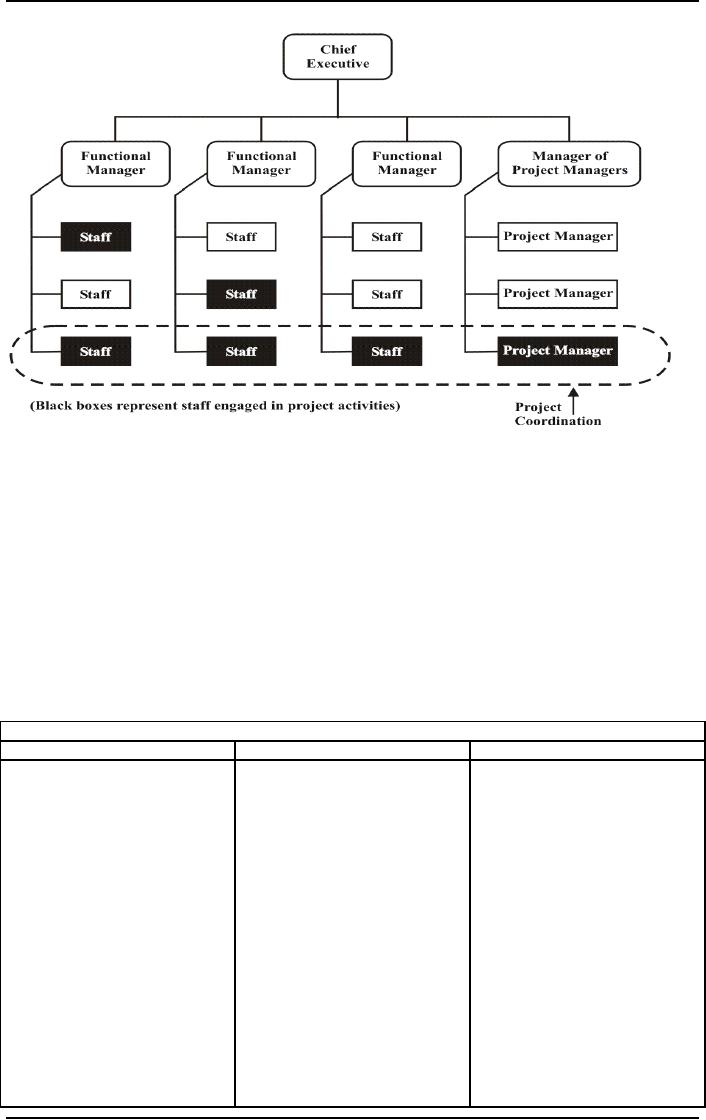
Organization
Development MGMT
628
VU
Figure
44. The Matrix
Organization
Matrix
organizations, like all organization
structures, have both
advantages and disadvantages, as
shown in
Table
14. On the positive side, this
structure allows multiple orientations.
Specialized, functional knowledge
can
be applied to all projects. New products
or projects can be implemented quickly by
using people
flexibly
and by moving between
product and functional orientations as
circumstances demand.
Matrix
organizations
can maintain consistency among
departments and projects by
requiring communication
among
managers. For many people,
matrix structures are
motivating and exciting.
On
the negative side, these
organizations can be difficult to
manage. To implement and maintain
them
requires
heavy managerial costs and
support. When people are assigned to
more than one
department,
there
may be role ambiguity and
conflict, and overall
performance may be sacrificed if
there are power
conflicts
between functional departments
and project structures. To
make matrix organizations
work,
organization
members need interpersonal and
conflict management skills.
People can get confused
about
how
the matrix works, and that
can lead to chaos and
inefficiencies
Table
14
Advantages,
Disadvantages and Contingencies of the
Matrix Form
Advantages
Disadvantages
contingencies
�
Make
�
Can
be very difficult
�
Dual
focus on unique
specialized,
introduce
without a
functional
knowledge
product
demands and
preexisting
supportive
available
to all projects.
technical
specialization
�
Uses
people flexibly,
�
Pressure
management
climate
for
high
�
Increases
role ambiguity,
because
departments
information
processing
stress
and anxiety by
maintain
reservoirs of
capacity
�
Pressure
for shared
assigning
people to more
specialists.
�
Maintains
than
one department
consistency
resources
�
Without
power balancing
between
different
between
product and
departments
and projects
functional
forms, lowers
by
forcing
communication
between
overall
performance
�
Makes
managers.
inconsistent
�
Recognizes
and provides
demands,
which may
mechanisms
for dealing
result
in unproductive
with
legitimate, multiple
conflicts
and short-term
sources
of power in the
crisis
management
�
May
reward political
organization.
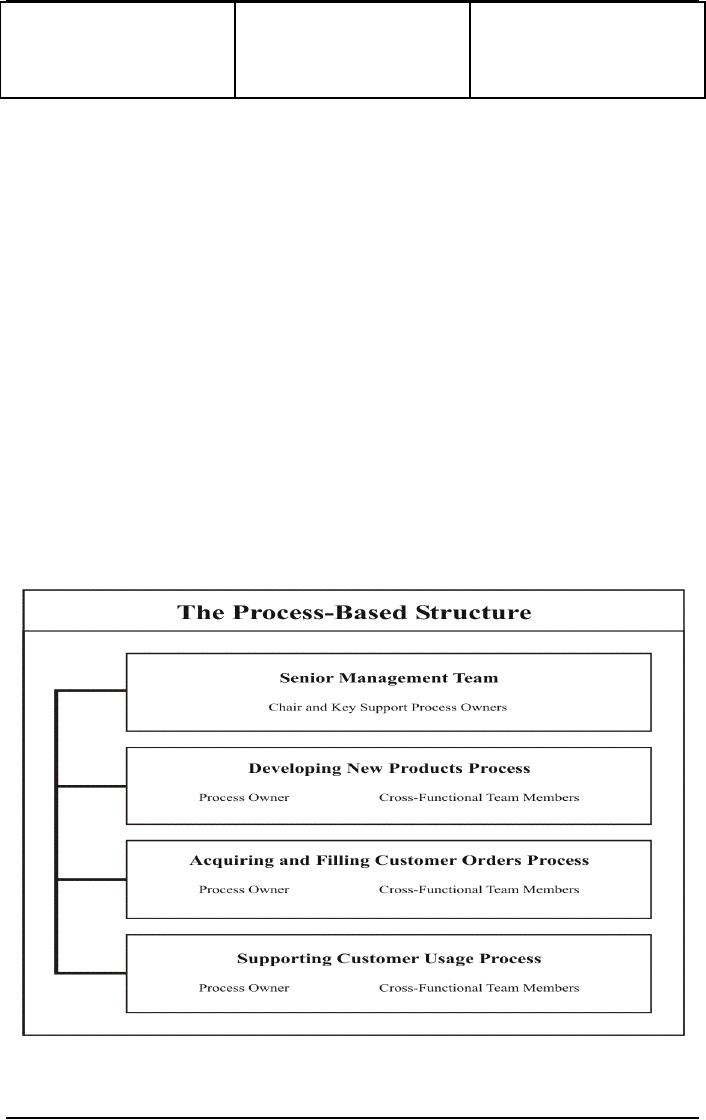
Organization
Development MGMT
628
VU
�
skills
as opposed
to
Can
adapt
to
technical
skills
environmental
changes
by
shifting emphasis
between
project and
functional
aspects
As
shown in Table 14, matrix
structures are appropriate under three
important conditions. First, there
must
be
outside pressures for a dual
focus. That is, a matrix
structure works best when there
are many customers
with
unique demands on the one hand and strong
requirements for technical sophistication
on the other
hand.
Second, a matrix organization is appropriate when the
organization must process a large amount
of
information.
Circumstances requiring such
capacity are few and include
the following: when external
environmental
demands change unpredictably and
there is considerable uncertainty in
decision making;
when
the organization produces a broad range of products or
services, or offers those outputs to a
large
number
of different markets, and
there is considerable complexity in
decision making: and when
there is
reciprocal
interdependence among the tasks in the
organization's technical core and
there is considerable
pressure
on communication and coordination
systems. Third, and finally,
there must be pressures
for
shared
resources. When customer
demands vary greatly and technological
requirements are strict,
valuable
human
and physical resources are
likely to be scarce. The
matrix works well under those
conditions because
in
facilitates the sharing of scarce
resources. If any of the foregoing
conditions is not met, a
matrix
organization
is likely to fail.
Process-Based
Structures:
A
radically new logic for structuring
organizations is to form
multidisciplinary teams around core
processes,
such
as product development, order
fulfillment, sales generation,
and customer support. As shown
in
Figure
45, process-based structures
emphasize lateral rather than vertical
relationships. All
functions
necessary
to produce a product or service
are placed in a common unit
usually managed by someone
called
a
"process owner." There are few
hierarchical levels, and the
senior executive team is relatively
small,
typically
consisting of the chair, the chief operating officer,
and the heads of a few key
support services
such
as strategic planning, human
resources, and
finance.
Figure
45: The Process-Based
Structure
Process-based
structures eliminate many of the
hierarchical and departmental
boundaries that can
impede
task
coordination and slow
decision making and task
performance. They reduce the enormous
costs of

Organization
Development MGMT
628
VU
managing
across departments up and
down the hierarchy. Process-based
structures enable organization to
focus
most of their resources on
serving customers, both
inside and outside the
firm.
The
use of process-based structures is
growing rapidly in a variety of manufacturing
and service
companies.
Typically
referred to as "horizontal" "boundary
less," or "team-based" organization, they are
used to
enhance
customer service at such
firm as American Express Financial Advisors,
The Associates, Duke
Power.
3M, Xerox, General Electric Capital
Services, at id the National b Provincial
building Society in
time
United Kingdom.
Although
there is no one right way to
design process- based
structures, the following features
characterize
this
new form of organizing.
Processes
drive structure. Process-based
structures are organized around the
three to five key
processes
that
define the work of the organization.
Rather than products or functions,
processes define the
structure
and
are governed by a "process owner."
Each process has clear
performance goals that drive
task
execution.
Work
adds value. To
increase efficiency, process--based
structures simplify and enrich
work processes.
Work
is simplified by eliminating nonessential
tasks and reducing layers of
management, and it is
enriched
by
combining tasks so that
learns perform whole
processes.
Teams
are fundamental. Teams
are the key organizing feature in a
process- based structure. They
manage
everything
from task execution to strategic
planning, are typically
self-managing, and are
responsible for
goal
achievement.
�
Customers
define performance. The
primary goal of any team in a
process-based structure is
customer
satisfaction.
Defining customer expectations
and designing team functions
to meet those
expectations
command
much of the team's attention.
The organization must value this
orientation as the primary path to
financial
performance.
Teams
are rewarded for
performance. Appraisal
systems focus on measuring
team performance
against
customer
satisfaction and other
goals, and then provide
real recognition for
achievement. Team-based
rewards
are given as much, if
not more, weight
than is individual
recognition.
Teams
are tightly linked to
suppliers and customers. Through
designated members, teams
have timely
and
direct relationships with vendors and
customers to understand and
respond to emerging
concerns.
Team
members are well informed and trained.
Successful
implementation of a process-based
structure
requires
team members who can
work with a broad range of
information, including customer
and market
data,
financial information, and
personnel and policy
matters. Team members also
need problem solving
and
decision-making skills and abilities to
address and implement solutions.
Table
15 lists
the advantages and disadvantages of
process-based structures. The
most frequently
mentioned
advantage is intense focus on
meeting customer needs,
which can result in
dramatic
improvements
in speed, efficiency, and customer
satisfaction. Process-based structures
remove layers of
management,
and consequently information
flows inure quickly and
accurately throughout the
organization.
Because process teams
comprise different functional
specialties, boundaries
between
departments
are removed, thus affording
organization members a broad view of the
work flow and a
clear
line
of sight between team
performance and organization
effectiveness. Process-based structures
also are
more
flexible and adaptable to
change than are traditional
structures.
Table
15: Advantages, Disadvantages, and
Contingencies of the Process-Based
Form
Advantages
Disadvantages
Contingencies
�
Focuses resources on customer �
Can threaten middle managers �
Uncertain and
changing
satisfaction
and
staff specialists
environments
�
Improves speed and efficiency, �
Requires changes in command- �
Moderate to large
size
often
dramatically
and-control
mindsets
�
Non-routine and
highly
�
Adapts to environmental change �
Duplicates scarce
resources
interdependent
technologies
rapidly
�
Requires new skills
and � Customer-oriented
goals
�
Reduces boundaries between knowledge
to manage
lateral
departments
relationships
and teams
�
Increases ability to see total �
May take longer to
make
work
flow
decisions
in teams
�
Enhances
employee
� Can be ineffective if
wrong
involvement
processes
are identified
�
Lowers costs because of
less
overhead
structure

Organization
Development MGMT
628
VU
A
major disadvantage of process-based
structures is the difficulty of changing
to this new organizational
form.
These structures typically require
radical shifts in mindsets,
skills, and managerial roles
-- changes
that
involve considerable time and
resources and can be
resisted by functional managers
and staff
specialists.
Moreover, process-based structures
may result in expensive
duplication of scarce resources
and,
if
teams are not skilled
adequately, in slower decision making as
they struggle to define and
reach
consensus.
Finally, implementing process-based
structures relies on properly
identifying key
processes
needed
to satisfy customer needs. If critical
processes are misidentified or ignored
altogether, performance
and
customer satisfaction are
likely to suffer.
Table
15 shows that process-based
structures are particularly appropriate
for highly uncertain environments
where
customer demands and market
conditions are changing
rapidly. They enable organizations to
manage
non-routine
technologies and coordinate work
flows that are highly
interdependent. Process-based
structures
generally appear in medium- to
large-sized organizations having several
products or projects.
They
focus heavily on customer-oriented goals
and are found in both
domestic and global
organizations.
Table of Contents:
- The Challenge for Organizations:The Growth and Relevance of OD
- OD: A Unique Change Strategy:OD consultants utilize a behavioral science base
- What an “ideal” effective, healthy organization would look like?:
- The Evolution of OD:Laboratory Training, Likert Scale, Scoring and analysis,
- The Evolution of OD:Participative Management, Quality of Work Life, Strategic Change
- The Organization Culture:Adjustment to Cultural Norms, Psychological Contracts
- The Nature of Planned Change:Lewin’s Change Model, Case Example: British Airways
- Action Research Model:Termination of the OD Effort, Phases not Steps
- General Model of Planned Change:Entering and Contracting, Magnitude of Change
- The Organization Development Practitioner:External and Internal Practitioners
- Creating a Climate for Change:The Stabilizer Style, The Analyzer Style
- OD Practitioner Skills and Activities:Consultant’s Abilities, Marginality
- Professional Values:Professional Ethics, Ethical Dilemmas, Technical Ineptness
- Entering and Contracting:Clarifying the Organizational Issue, Selecting an OD Practitioner
- Diagnosing Organizations:The Process, The Performance Gap, The Interview Data
- Organization as Open Systems:Equifinality, Diagnosing Organizational Systems
- Diagnosing Organizations:Outputs, Alignment, Analysis
- Diagnosing Groups and Jobs:Design Components, Outputs
- Diagnosing Groups and Jobs:Design Components, Fits
- Collecting and Analyzing Diagnostic information:Methods for Collecting Data, Observations
- Collecting and Analyzing Diagnostic information:Sampling, The Analysis of Data
- Designing Interventions:Readiness for Change, Techno-structural Interventions
- Leading and Managing Change:Motivating Change, The Life Cycle of Resistance to Change
- Leading and managing change:Describing the Core Ideology, Commitment Planning
- Evaluating and Institutionalizing Organization Development Interventions:Measurement
- Evaluating and Institutionalizing Organization Development Interventions:Research Design
- Evaluating and Institutionalizing Organization Development Interventions
- Interpersonal and Group Process Approaches:Group Process
- Interpersonal and Group Process Approaches:Leadership and Authority, Group Interventions
- Interpersonal and Group Process Approaches:Third-Party Interventions
- Interpersonal and Group Process Approaches:Team Building, Team Building Process
- Interpersonal and Group Process Approaches:Team Management Styles
- Organization Process Approaches:Application Stages, Microcosm Groups
- Restructuring Organizations:Structural Design, Process-Based Structures
- Restructuring Organizations:Downsizing, Application Stages, Reengineering
- Employee Involvement:Parallel Structures, Multiple-level committees
- Employee Involvement:Quality Circles, Total Quality Management
- Work Design:The Engineering Approach, Individual Differences, Vertical Loading
- Performance Management:Goal Setting, Management by Objectives, Criticism of MBO
- Developing and Assisting Members:Career Stages, Career Planning, Job Pathing
- Developing and Assisting Members:Culture and Values, Employee Assistance Programs
- Organization and Environment Relationships:Environmental Dimensions, Administrative Responses
- Organization Transformation:Sharing the Vision, Three kinds of Interventions
- The Behavioral Approach:The Deep Assumptions Approach
- Seven Practices of Successful Organizations:Training, Sharing Information